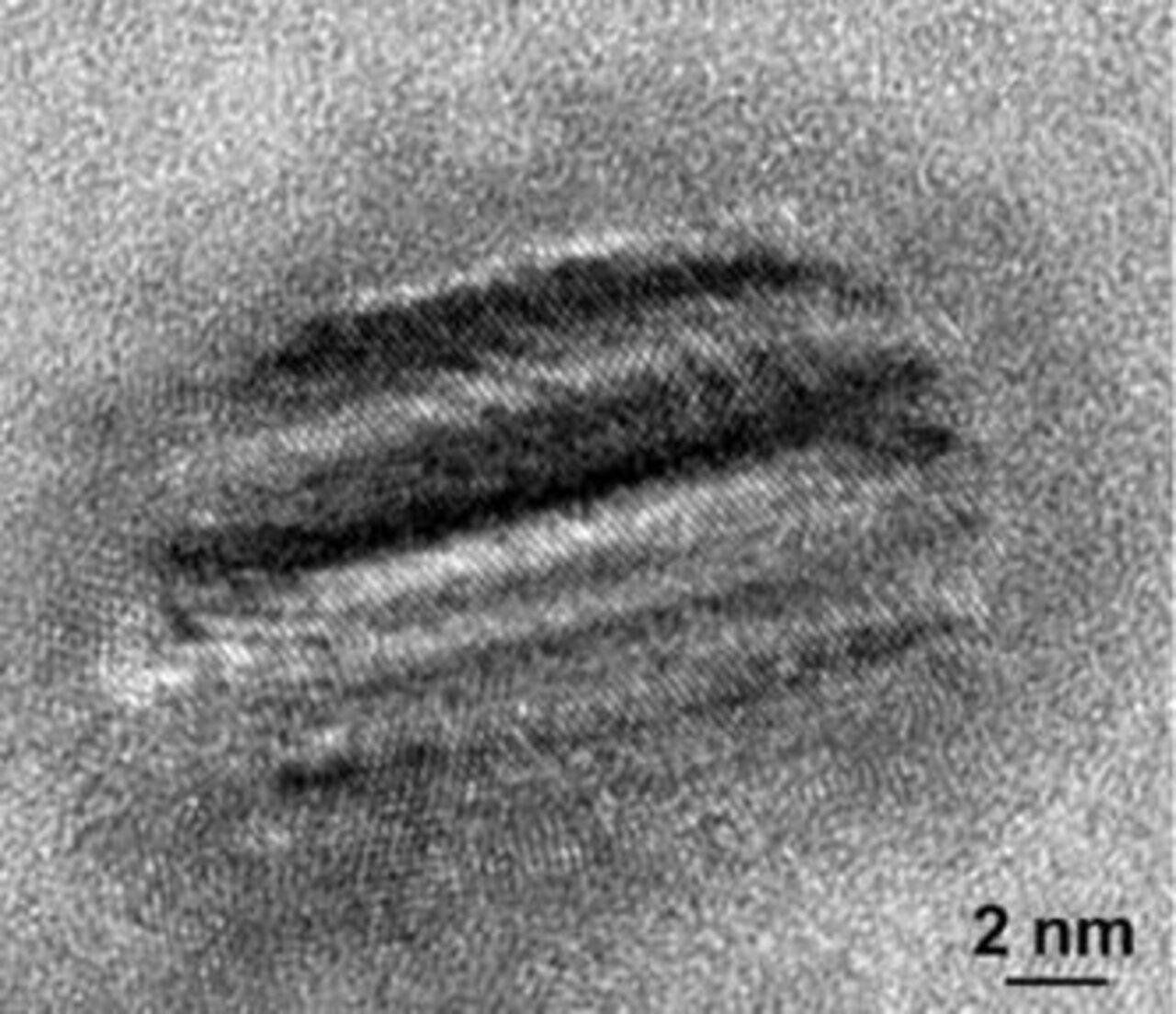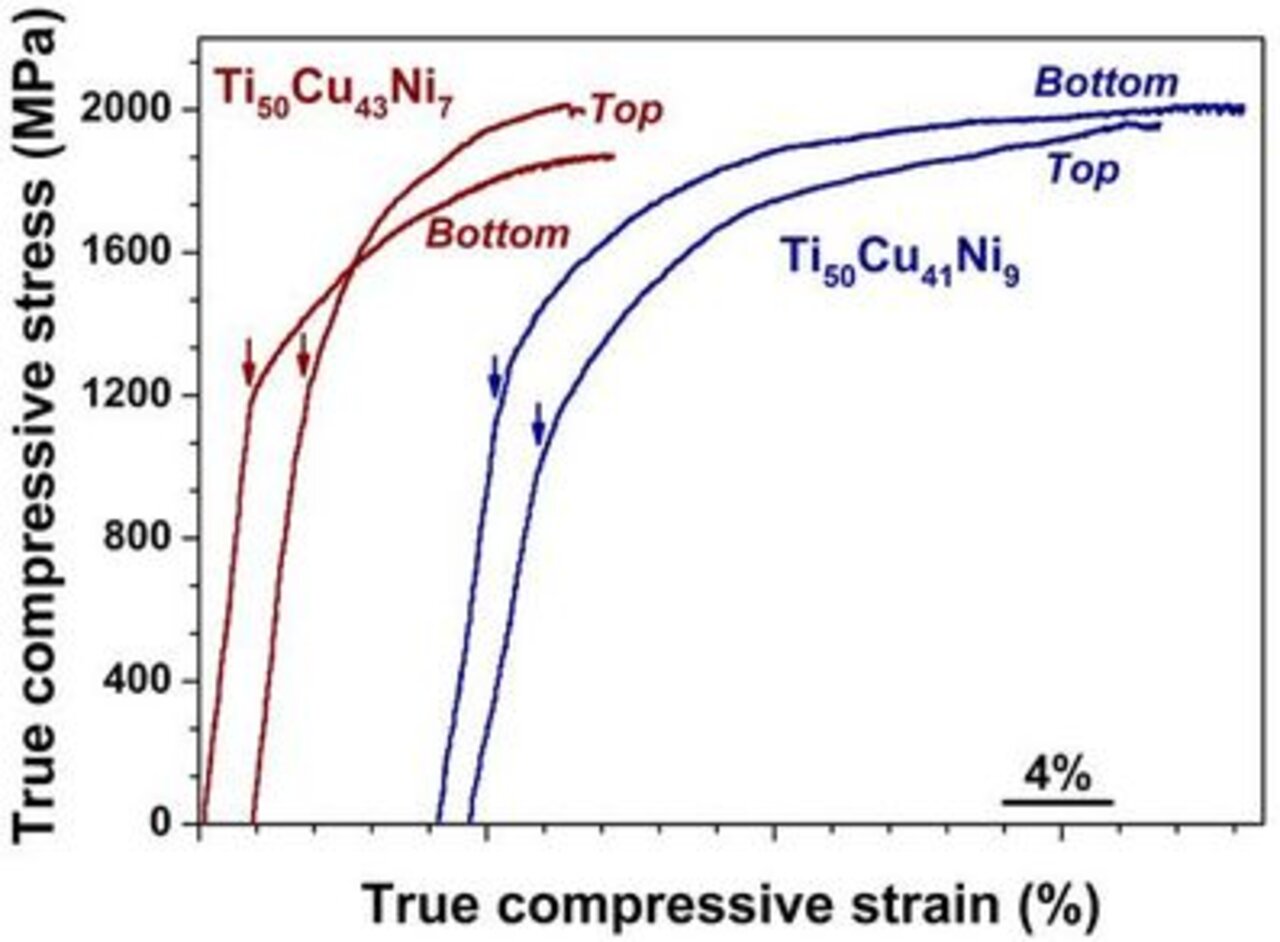
Metallic glasses and bulk metallic glasses are high-strength metallic alloys with an extraordinary high elastic strain of around 2%. These unique mechanical properties are a direct result of the lack of translational symmetry in amorphous alloys. The absence of a conventional structural ordering makes different deformation mechanisms become active: Instead of dislocation operation as in crystals, nanometre-thick shear bands are the carriers of plastic strain in these disordered materials. Unfortunately, the formation of shear bands is based on a shear-softening phenomenon, which generally ends up in catastrophic failure after marginal plastic strains.
Premature failure can be avoided if heterogeneities are introduced into the glass. These inhomogeneities interact with shear bands just being formed or propagating and retard the development of fracture-causing defects (Fig. 1). This way multiple shear bands can be generated and the overall plastic strain increases [1].
In our research group at the IKM we develop novel compositions derived from shape memory alloys, which can vitrify upon quenching and which can precipitate shape memory crystals during slower cooling or upon annealing. These particular structural heterogeneities allow to combine the characteristics of the shape memory phase and the glassy phase to get a new response to mechanical loading. Our research efforts specifically concentrate on two different aspects:
These alloys are fully glassy but may have quenched-in nuclei, which appear to grow polymorphically into shape memory nanocrystals during deformation [2]. A prototype alloy system is the Cu-Zr system [2,3], which contains a high-temperature shape memory phase (B2 CuZr). Due to the ability to transform martensitically some of these B2 CuZr nanocrystals moreover exhibit twins (Fig. 2). The deformation-induced precipitation of shape memory crystals, which subsequently can twin, is believed to be responsible for the improved plastic deformability [2].
We aim to understand how these heterogeneities precipitate during deformation and what the role of the quenching rate, alloy composition and deformation conditions (strain rate and temperature) in this process is. The ultimate goal is to determine the mechanisms leading to the structural changes in these alloys and how they in turn affect the deformation behaviour.
When the composition and the cooling rates are adjusted properly B2 CuZr crystals can precipitate in a glassy matrix already upon cooling [4,5]. Micrometre-size B2 CuZr crystals interact with propagating shear bands and additionally a martensitic phase transformation can be revealed in these crystals (Fig. 1). Not only do such composite microstructures lead to an enhanced fracture strain (comparable to the transformation-induced plasticity (TRIP) effect in conventional alloys) but also result in work hardening [4,5,6].
In our group the effect of composition and cooling rate on the microstructure and phase formation is investigated – not just for CuZr-based alloys but also for Ti-Cu-Ni alloys (Figs. 3 and 4)[7]. We seek to understand the complex interactions between the crystals and the matrix during deformation and to optimise the microstructure to enhance the plastic strain without sacrificing the high strength. This includes modification of the as-cast glasses through special annealing treatments.
References:
[1] J. Eckert, J. Das, S. Pauly and C. Duhamel, Advanced Engineering Materials 9, 443 (2007).
[2] S. Pauly, S. Gorantla, G. Wang, U. Kühn and J. Eckert, Nature Materials 9, 473 (2010).
[3] S. Pauly, G. Liu, S. Gorantla, G. Wang, U. Kühn, D.H. Kim and J. Eckert, Acta Materialia 58, 4883 (2010).
[4] S. Pauly, G. Liu, G. Wang, U. Kühn, N. Mattern and J. Eckert, Acta Materialia 57, 5445 (2009).
[5] K.K. Song, S. Pauly, Y. Zhang, P. Gargarella, R. Li, N. Barekar, U. Kühn, M. Stoica and J. Eckert, Acta Materialia 59, 6620 (2011).
[6] K.K. Song, S. Pauly, Y. Zhang, R. Li, S. Gorantla, N. Narayanan, U. Kühn, T. Gemming and J. Eckert, Acta Materialia 60, 6000 (2012).
[7] P. Gargarella, S. Pauly, K.K. Song, J. Hu, N.S. Barekar, M.S. Khoshkhoo, A. Teresiak, H. Wendrock, U. Kühn, C. Ruffing, E. Kerscher and J. Eckert: Ti-Cu-Ni shape memory bulk metallic glass composites. Acta Mater. 61, 151 (2013).
Dr. Uta Kühn
Dr. Simon Pauly



